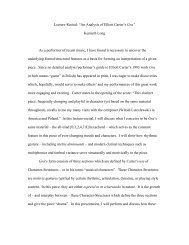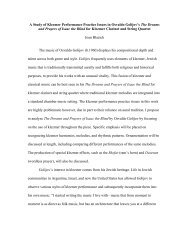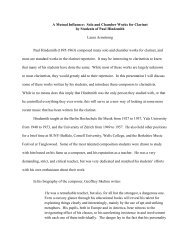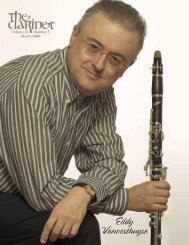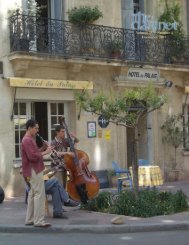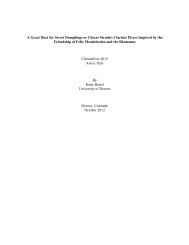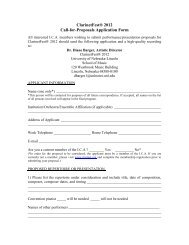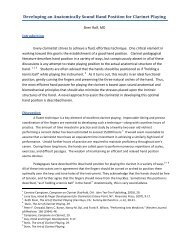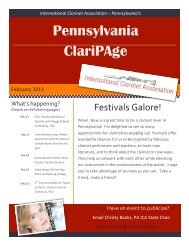Volume 33 Number 3 June 2006 - International Clarinet Association
Volume 33 Number 3 June 2006 - International Clarinet Association
Volume 33 Number 3 June 2006 - International Clarinet Association
- No tags were found...
Create successful ePaper yourself
Turn your PDF publications into a flip-book with our unique Google optimized e-Paper software.
PART III: THOUGHTS<br />
ON ARTICULATION<br />
The author has surveyed early clarinet<br />
specialists from around the world while<br />
writing the D.M.A. dissertation “Early<br />
<strong>Clarinet</strong> Performance as Described by<br />
Modern Specialists, with a Performance<br />
Edition of Mathieu Frédéric Blasius’s IIe<br />
Concerto de clarinette,” under the supervision<br />
of Dr. Kelly Burke at the University of<br />
North Carolina at Greensboro. Third in a<br />
series, this article will examine techniques<br />
and performance practice of articulation<br />
on the early clarinet. Following articles<br />
will discuss reeds, instrument selection<br />
(originals, modern replicas), and selected<br />
repertoire with reference to performance<br />
practice of the early 19th century.<br />
Studying the early clarinet has enhanced<br />
and clarified my understanding<br />
of the essays by C.P.E.<br />
Bach, Lefèvre, Leopold Mozart, Quantz<br />
and Türk. Playing through the musical<br />
examples with a boxwood instrument<br />
changes the perception of notation, articulation,<br />
accentuation, phrasing, and suggests<br />
many parallels to rhetoric. The descriptions<br />
and illustrations are materialized<br />
by the natural response of the instrument.<br />
This experience has consequently<br />
helped me appreciate the lesser-known<br />
works of the clarinet repertoire.<br />
With respect to articulation, the discourse<br />
is analogous between string, keyboard<br />
and woodwind treatises. Period<br />
bows and keyboards were not designed to<br />
play sostenuto, and therefore a natural<br />
decay of sound occurred after each articulation:<br />
“Leopold Mozart taught that ‘if in a<br />
musical composition two, three, four, and<br />
even more notes be bound together by a<br />
half-circle [slur] … the first of such united<br />
notes must be somewhat more strongly<br />
stressed, be the remainder slurred on to it<br />
quite smoothly and more and more quietly.”<br />
1 The narrow bore and soft reed of the<br />
early clarinet respond in a similar manner.<br />
When a performer attempts to eliminate<br />
the naturally occurring decay — blowing<br />
through it — the instrument sounds choked<br />
and unresponsive.<br />
Woodwind articulation is analogous to<br />
bowing for string instruments, fingerings<br />
for keyboard players, and text for vocalists.<br />
Lefèvre makes this parallel in his Méthode:<br />
Page 38<br />
Early <strong>Clarinet</strong> Pedagogy<br />
for Modern Performers<br />
by Luc Jackman<br />
L’articulation des instruments à<br />
cordes se fait par le moyen, ou de<br />
l’archet, comme le violon, ou des<br />
doigts, comme la harpe, [et] la guittare.<br />
Celle des instruments à vent se<br />
fait par la langue: sans la langue il<br />
est impossible de bien jouer de la<br />
clarinette, elle est a cet instrument<br />
ce que l’archet est au violon; l’action<br />
de la langue qui determine l’articulation<br />
s’appelle coup de langue,<br />
pour donner les coups de langue il<br />
faut boucher l’anche avec la langue<br />
puis la retirer pour introduire l’air<br />
dans l’instrument en prononçant la<br />
syllabe TÛ. 2<br />
The beginning of a tone and its relationship<br />
to the preceding and following<br />
ones is intimately related to the quality of<br />
a sound. Proper articulation is perhaps the<br />
most important parameter for successfully<br />
playing music from the 18th and early<br />
19th centuries, as it is used to stress dissonance,<br />
clarify harmony, emphasize melodic<br />
line, define rhythmical structure, and<br />
separate phrases or sections of a phrase.<br />
Performers are responsible for crafting articulations<br />
that will ultimately “sing” the<br />
musical phrase.<br />
The main differences between articulating<br />
on early and modern clarinet arise<br />
from the wider angle at which the former<br />
is played, which places the reed lower in<br />
the mouth, thus reducing the distance traveled<br />
by the tongue from a neutral position;<br />
the reed position, if one chooses to veer<br />
from the comfortable untersichblasen<br />
(mandibular embouchure); the variety of<br />
resistances between notes and fingerings,<br />
and the greater flexibility of the reed, used<br />
to counterbalance the high resistance of<br />
the instrument. The early clarinet offers a<br />
great variety of articulations: Backofen<br />
describes three ways of articulating on the<br />
early clarinet, using the tongue, lips, or<br />
throat. Another technique described in<br />
early clarinet methods is the air attack, or<br />
chest articulation: It is produced by lightly<br />
pushing the abdominal muscles out, as<br />
when pronouncing a gentle yet firm “ha.”<br />
THE CLARINET<br />
The later is especially useful in soft entrances,<br />
or in combination with other<br />
types of articulation.<br />
With the reed-under technique, tonguing<br />
is done largely the same as with modern<br />
reed instruments — produced through<br />
different syllables. Consonants influence<br />
placement, motion, and release of the<br />
tongue. Vowels place the middle and back<br />
portions of the tongue at different heights:<br />
An “ah” sound brings about a lower tongue<br />
position than an “ee” or French “u” sound.<br />
The early methods describe two basic consonants<br />
for tonguing, which are a “t” sound<br />
and a softer “d” sound. It is also possible to<br />
articulate with the tongue using “l,” “n”<br />
and “th.” With the reed-above, these consonants<br />
may be performed by the interaction<br />
of the tongue with the hard palate.<br />
Lip articulations are performed by tightening<br />
the grip around the reed and mouthpiece.<br />
The consonants visualized for this<br />
technique are “p” and “w.” The jaw may<br />
assist the lip muscles in this technique, but<br />
if too much pressure is needed to close off<br />
the air input, the reed is probably too hard.<br />
Throat articulation is the opening and closing<br />
of the soft palate to let the air through.<br />
This is performed with the “gu” and “k”<br />
sounds, or by pretending to cough gently<br />
into the clarinet.<br />
Experimenting with the above-mentioned<br />
techniques provides the clarinetist<br />
with a wide palette of articulation for musical<br />
expression: They can reach a level<br />
of subtlety that is not possible on the modern<br />
instrument. Where to start was the<br />
main issue for me… The instrument itself<br />
led the way at first, however playing<br />
within a chamber music setting proved to<br />
be the most educational experience in<br />
developing my palette of articulations.<br />
The aforementioned techniques will be<br />
illustrated through the clarinet literature<br />
in subsequent articles.<br />
BIBLIOGRAPHY<br />
Bach, C.P.E. Versuch über die wahre Art<br />
des Clavier zu spielen. Translated by<br />
William J. Mitchell. New York: W.W.<br />
Norton & Co., 1949.




